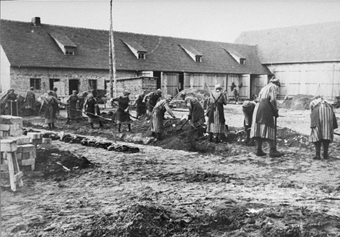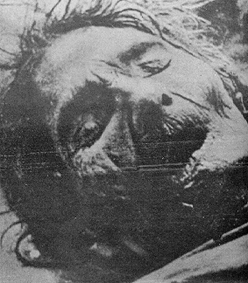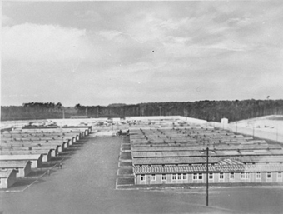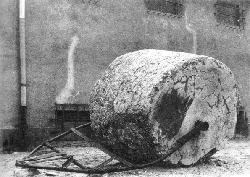After the war began, the population of the camp became more international, and soon there were prisoners coming from 20 European countries. The conditions of life in Ravensbrück were as shameful and difficult as in all the other concentration camps--death by starvation, beating, torture, hanging, and shooting happened daily. The women who were too weak to work were transferred to be gassed at the Uckermark "Youth Camp" located nearby Ravensbruck or to Auschwitz. Others were killed by lethal injections or used for "medical" experiments by the SS doctors. Several SS companies surrounded the camp where the prisoners had to work day and night until they died by weakness and illness [see the list of Ravensbrück sub-camps].
Due to the constant growth of the population, the camp had to be enlarged four times during the war. By the end of 1941, there were 12,000 prisoners. In 1942, several convoys of Russian women were transferred to Ravensbrück. By the end of 1942, the population was 15,000, and it reached 42,000 by the end of 1943. As in the others concentration camps, Ravensbrück had a crematory, and in November 1944, the SS decided to build a gas chamber. At this time, the total population of the camp was 80,000.

A work team in Ravensbrück
All in all, more than 132,000 women and children were incarcerated in Ravensbrück. It is estimated that 92,000 of them died in the camp by starvation, executions, or weakness. During the last months of the war, and due to the rapid advance of the Russian Army, the SS decided to exterminate as many prisoners as they could, in order to avoid any testimony about what happened in the camp. For example, 130 babies and pregnant women were gassed in March 1945.
At the end of March 1945, the SS decided to transfer the archives of the camp and the machines of the workshops to a safer place. On April 27 and 28, 1945, they ordered the woman still able to walk to leave the camp in a Death March. Only 3,000 exhausted or ill women were left in the camp, as well as 300 men.

The hell of Ravensbrück...
The camp was liberated by the Russian Army on April 30th, 1945. The survivors of the Death March were liberated in the following hours by a Russian scout unit.
Every two or three weeks, the SS commandant of the camp Suhren and the SS doctors Schwarzhuber and Pflaum selected the ill or weak women for the "transport to Mittweida". The women had to lift their skirts over their hips and run in front of the SS guards and doctors. Women with swollen feet, injuries, or scars or those simply too ill or too weak to run were immediately selected for a "recovery" period in Uckermark. This "recovery" period consisted in fact of being jailed in sealed barracks without medical care and food until death. But most of the selected women never arrived in the Uckermark "Youth Camp". They were gassed in special vans transformed in mobile gas chambers. The exhaust pipe of the engine was directly connected to the van's freight compartment, and gassing was done in 15-20 minutes. One of those gas vans was a captured sanitary truck from the Dutch Army. Others trucks were sealed German freight trucks, often named by the prisoners "Green Mina". The so-called "transport to Mittweida" was an SS code name for gassing. "Mittweida" was supposed to be a place where prisoners could recover from their slave work. Of course, it was an imaginary place and "Mittweida" was just a synonym for "gas chamber".
Hundreds of children were incarcerated in Ravensbrück. The cruelty and the sadism of the Nazis against the children had no limits, and the fate of those little victims was absolutely awful. Children and babies were in fact sentenced to death before they were born. Newborn babies were immediately separated from their mother and drowned or thrown into a sealed room until they died. Most of the time, this was done in front of the mother. There are dozen of testimonies about children thrown alive into the crematory, buried alive, poisoned, strangled, or drowned in Ravensbrück. Several children were also used for sadistic "medical" experiments. Hundreds of little girls, sometimes only 8, were sterilized by direct exposure of genitals to X-rays. In the early months of Ravensbrück, children were immediately killed. The SS doctor Rosenthal and his girlfriend Gerda Quernheim aborted by force pregnant women, and this was often done using bestial methods. Later, newborn children were sometimes allowed to survive, but due to the lack of food and the awful sanitary conditions, these babies died very soon.
Only the strongest children could survive. Those children had to work day and night with the women in the workshop and help them with the heaviest labor. Only very few of these children survived the war.



